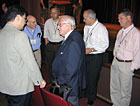INDUSTRIAL
In a wide-ranging talk, S. Forbes Pearson of Star Refrigeration, Ltd., Scotland, talked about trends in industrial refrigeration. He noted many of those trends are being driven by factors such as:• Global warming.“The need to mitigate the rate of global warming influences industrial refrigeration by restricting the choice of refrigerants available and making it important to improve efficiencies.”
• Safety legislation.“The degree of precaution is related to the amount of ammonia in the system. Conventional ammonia refrigeration systems, especially in the U.S., have not been designed with charge minimization in mind. (But) it is possible to design systems that will operate with much lower refrigerant charges than conventional systems.” He noted some of those include “direct systems that will operate with less than 1/10th of the charge of a conventional system” and “secondary systems with less than 1/100th of the charge of a conventional system.”
• Electronic and computer advances.“It is possible to control and indicate refrigerating systems remotely and in real time, thus making it possible to acquire data that would have been prohibitively expensive (before). The data can be transmitted to any location, even across international boundaries. This has also allowed for variable-speed drives to be a practical possibility for large units.”
• Efficiency legislation.“Legislation will cause a trend to the use of more efficient refrigerating systems.”
• Legionnaires disease.“Legislation in many countries makes it mandatory to declare the presence of cooling towers on a site and give to local inspectors power to shut down the cooling tower on suspicion it might have been the source of a case of Legionnaires Disease. There has therefore been a trend away from the use of evaporative cooling for heat rejection from refrigerating systems. However, such a trend will have to be reversed if system efficiency is to be increased.”
• Multi-frame computer cooling.“Computers have become thousands of times more powerful. Power requirements continue to increase. In view of the number of such installations and the large amounts of heat to be rejected, it is obvious that this application will drive innovation to provide more efficient means of proving the refrigeration.”
• IT systems.“The problem with IT systems is not the sheer size of the load, but the intensity of the load. There will be a trend towards new methods of carrying heat away from cabinets.”

S. Forbes Pearson, center, is surrounded by industry colleagues following his talk on industrial refrigeration at Purdue University.
INDUSTRIAL
Peter Egolf of the Institute for Thermal Sciences at the University of Applied Sciences of Western Switzerland talked about the potential for magnetic heating and refrigeration which he said can be achieved in an oilless and compressor-less manner.He said, “The magnetic heating technology is based on the adiabatic magnetization/demagnetization process. Instead of compressing a gas - as in conventional heat pump - here, a magneto caloric material is magnetized. By this, the solid material heats up. A fluid flowing through the material extracts the heat. Because the materials are solid and a fast heat transfer, porous structure magneto caloric wheels are applied.
“After a first cooling by heat extraction, the magneto caloric material is demagnetized. This leads to a further cooling. This process is in analogy to the expansion of the gas in the conventional system.”
In terms of refrigeration, he said, “A magnetic refrigerator works like a magnetic heat pump. But now, the rejected heat is not used. It is just transferred to the surroundings of the machine. Important in this application is the heat absorption at the lower end, which is in the interior of the refrigerator chamber.” He said such applications could be household refrigerators, central cooling systems, room air conditioners, and supermarket refrigeration.
CHINA FACTOR
R.Z. Wang of Shanghai Jiao Tong University told conference attendees that “China refrigeration and HVAC industries have been developing rapidly in the last 10 years. The high economic growth rate and the increasing building construction have helped the booming HVACR applications.“China has now established its own standard and certification system to evaluate the HVACR products which can meet most of the needs for the world market.”
He noted that research and development efforts in China are coming from internal Chinese companies, worldwide manufacturers who have established a presence in the country, and from universities.
The goal, he said, is to change the negative ‘”Made in China” image to a more positive “researched and developed in China.”
Publication Date:09/08/2008


Report Abusive Comment